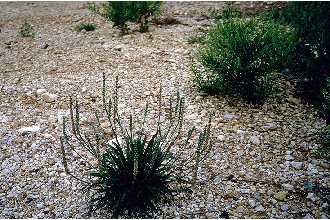Redseed Plantain
Scientific Name: Plantago rhodosperma Decne.

| General Information | |
|---|---|
| Usda Symbol | PLRH |
| Group | Dicot |
| Life Cycle | Annual |
| Growth Habits | Forb/herb |
| Native Locations | PLRH |
Plant Guide
Use soil moisture sensors to measure the soil moisture of Redseed Plantain.
Fact Sheet
Alternate Names
Tallow weed, Redseed Indianwheat
Uses
Wildlife: Redseed plantain is a cool season forage recommended for upland wildlife plantings and in range seeding mixes. The seed is known to be consumed by game birds such as bobwhite quail and mourning doves, and the foliage is eaten by bobwhite quail, Rio Grande wild turkeys, white-tailed deer, and cattle. Redseed plantain has been shown to be an important component in the diets of both scaled and bobwhite quail in southwest Texas. Erosion: Redseed plantain also can be used in many types of conservation plantings, such as stream-side buffers and filter strips.
Status
Please consult the PLANTS Web site and your State Department of Natural Resources for this plant’s current status (e.g. threatened or endangered species, state noxious status, and wetland indicator values).
Description and Adaptation
Adaptation
Adaptation
Redseed plantain is a cool season, annual with a slender taproot. Leaves are oblanceolate to 35 cm. long and 5 cm. wide, but usually much smaller. The leaves are grayish-green in color, pubescent, with margins that are entire to coarsely pectinate or salient-dentate. The scapes (inflorescences) are one to several, hirsute, and shorter than to exceeding the leaves in height. The spikes are up to 2 dm. long and 1 cm. thick. Each flower produces two seeds that are bright red to reddish black in color. The seeds are 2-3 mm. long, more than half as wide, nearly flat on both sides, and have a thin pale margin. STN-496 Germplasm contains 322,000 seeds per pound. Distribution: Please consult the Plant Profile page for this species on the PLANTS Web site. Forrest Smith, South Texas Natives
Establishment
Plantains are established from seed. Germination tests conducted by the South Texas Natives Project (2006) found germination rates ranging from a low of 40% to a high of 80% and rapid initiation of germination following the onset of favorable conditions (germination < 36 hours). Plantains typically take 180 days from planting to seed maturity. For direct seeding, broadcast or drill seed during September through December into a clean, weed free seedbed. Seeds should be covered from ¼ to ½” depth to ensure good soil to seed contact. The full seeding rate for redseed plantain is 10 PLS pounds per acre for a pure stand. When planting this as a component of a seed mixture, the seeding rate should be adjusted to the desired percent of the mix. Forrest Smith, South Texas Natives
Management
Redseed plantain requires little management, Seed production plots will require occasional weeding, It can survive in both droughty and moist conditions, For seed production purposes, occasional irrigation during extremely droughty periods may help seed fertility, Redseed plantain can be harvested with a combine, When harvesting redseed plantain, run the combine’s cylinder speed at 1100 RPM, the concave at 6 mm, the sieve open 3/8", and the fan at 600 rpm, To clean the seed, it should first be run through a Westrup brush machine and can then be cleaned further using a clipper style seed cleaner, It is recommended that after cleaning, the seed should be stored at 45o F and less than 50% humidity, Use soil moisture sensors to measure the soil moisture of Redseed Plantain., Seed harvested from seed increase plots of STN-496 Germplasm at Kingsville in June 2008 had 88% viability, 12% dormancy, 79% active germination, and 87,43% pure live seed, Seed yield from Kingsville plantings was 400 lbs, pure live seed per acre, Seed harvested from Beeville plots in May 2007 had 98% viability, 45% dormancy, 53% active germination, and 89% pure live seed, Seed yield in Beeville was 387 lbs, pure live seed per acre,
